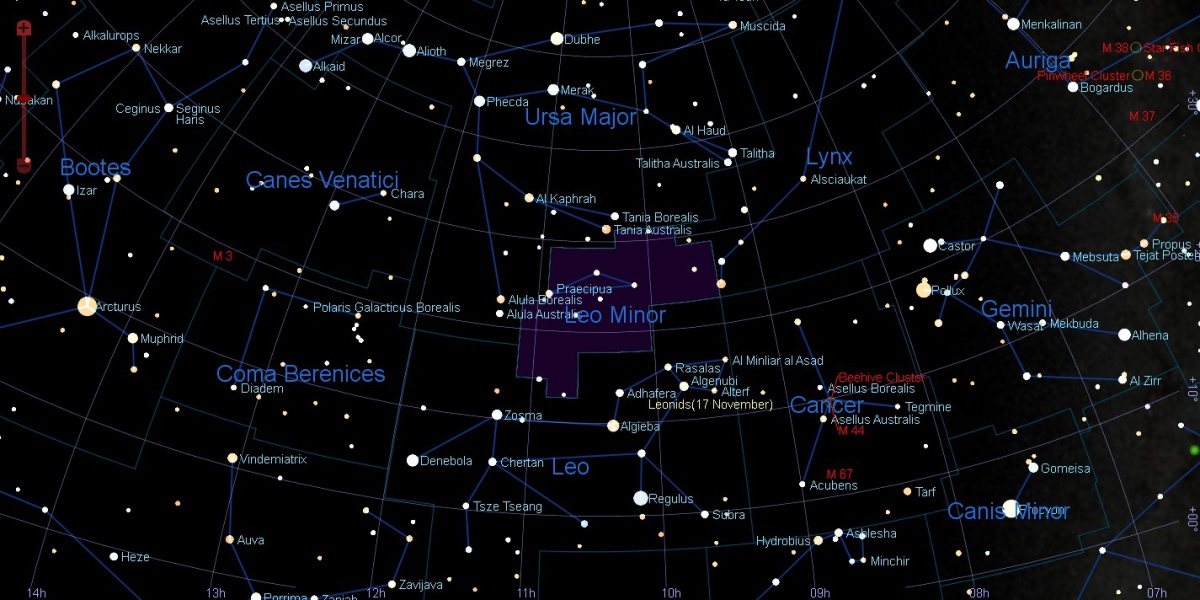Tips on How to View the Leonid Meteor Shower
Since mid-March of this year, the UNH Observatory has been closed to students and the public. During this time, the observatory staff has kept in touch with its friends, guests and supporters through periodic livestreams and postings to the observatory Facebook page and will continue to do so until we reopen. This may even continue beyond the pandemic. If you’ve been waiting for the observatory to reopen, please be patient. We are working on plans to safely reopen, but with Covid-19 cases on the increase, it is unlikely this will happen until sometime next year. Check our Facebook page for updates and postings to keep informed as to what’s up in the sky for you and your family to see.
I do have some good news to share with you. UNH Cooperative Extension has teamed up with UNH’s College of Engineering and Physical Sciences (CEPS) to sponsor a new level of UNH Observatory outreach and education. This AstroNotes blog is a small part of that new and welcome support of the observatory’s efforts to reach New Hampshire residents and beyond with opportunities to experience and learn about all things celestial.
Viewing a Meteor Shower
Have you ever looked up into the nighttime sky on a clear, moonless night and saw a flash of light streak across the sky? Well, if you have, you’ve witnessed one of nature’s rewards for those who venture out after dark in search of the unknown, or at least the unfamiliar. You might know them as “shooting stars,” but astronomers call these fleeting flashes meteors and they can be seen on any given night, especially during the dark of the moon. The darker the sky, the more likely you are to see a meteor. If you’ve never seen one, you just might get the chance this week.
Each year, around November 17, Earth intersects the path of periodic Comet Tempel-Tuttle (Comet 55P). Comets are named for their discoverers. In the case of Comet Tempel-Tuttle, two astronomers are credited with its discovery, William Tempel in December of 1865 and Horace Tuttle in January of 1866. The comet has a 33-year orbit around the sun. This means that every 33 years, the comet’s path around the sun is replenished with fresh particles that were once a part of the comet’s frozen nucleus. Each year from about November 6 until about November 30, Earth passes through this stream of small particles. On or about November 17, we pass through the densest part of the dust stream and that’s when the Leonid shower reaches its peak.
On the evening of Tuesday, November 17 and on into the early morning hours of Wednesday, November 18, Earth will pass through the dense portion of the dust stream — small fragments from Comet Tempel-Tuttle. During the shower’s peak, predicted to occur between 3 and 6 a.m. early Wednesday morning, the annual Leonid Meteor Shower will brighten our skies with between 10–15 meteors per hour. If you live near a city or where there are lots of streetlights or parking lot lights, you will see fewer that the predicted 10-15 per hour, but it is still well worth watching. Leonid meteors can encounter Earth’s atmosphere at a whopping 160,000 miles per hour. This high speed causes many shower members to vaporize and flare brilliantly before they fade out.
If you’re interested in going meteor hunting this week, all you have to do is go outside in the late evening through the early morning hours of Tuesday and Wednesday, November 17 and 18. Of course, the sky has to be clear. If it is, this year’s Leonid shower promises to be very good because the moon will be a very slender, crescent that will set at 6:28 p.m. EST — hours before we start hunting for Leonids.
To make your quest successful, dress warmly and allow your eyes to become “dark-adapted.” This means you must keep your eyes away from all sources of white light for 20–30 minutes. After that, you’ll be much more likely to spot meteors as long as you don’t expose your eyes to bright lights. When you go outside, face the northeast. If you glance to your left, you’ll see the familiar Big Dipper rising. Cast your gaze to the right (to the east of the dipper) and get ready to bag your first Leonid.
Use the star chart to help you find the backward question-mark-shaped group of stars that form the head of Leo, the mythological lion. The chart marks the radiant of the shower, which is the apparent point of origin in the sky where the meteors can be traced back to. You don’t have to face that same place in the sky all night, but this is a good place to start. Just face east and let the Leonids find you.

By the way, why are they called the Leonids? Annual meteor showers, those that occur at the same general time each year, are named for the constellation they appear to radiate from in the sky. So, the Leonid meteors appear to originate from the point in space near the head of the mighty lion, Leo.
If you’re successful with the Leonids (and even if you’re not), you’ll surely want to observe next month’s peak of the mighty Geminid Meteor shower that peaks on December 13 and 14. Let us know how you made out by commenting on our Facebook page. You can also find more information on Space.com.
Wishing all of you clear skies for the Leonids!
John Gianforte, the Sky Guy
Top photo: A colorful meteor streaks across the sky viewed from Durham, NH. Some meteors rival the brightness of the brightest stars in the sky. Image, courtesy, John S. Gianforte.
